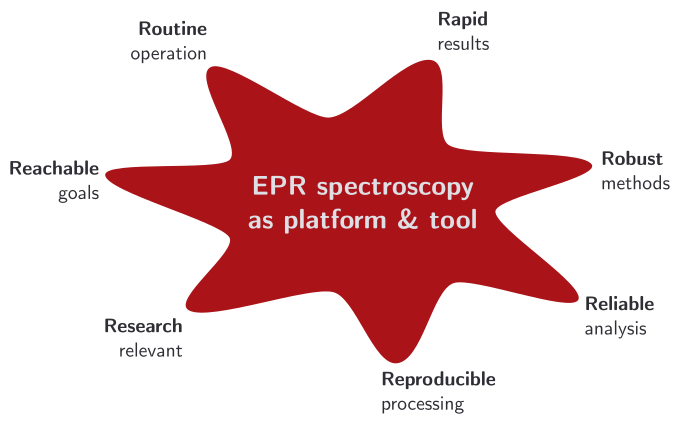EPR spectroscopy as platform & tool
The vision is to develop EPR spectroscopy as a platform and tool to routinely investigate state-of-the-art scientific questions of high relevance, currently with a particular emphasise on organic electronic materials and questions of power conversion.

EPR spectroscopy as a platform and tool: The vision consists of seven aspects, the seven “R“‘s, thar are detailed each on their individual pages. The focus is on automating as much as possible and on providing an open platform (both, hard and software) readily extensible to address new an unforeseen questions.
Routine operation
To be of use for a broader community and audience, EPR spectroscopy needs to be routinely applicable to many different samples and questions. This requires standard protocols, high availability, short overall measurement and analysis times, to name but a few aspects.
Rapid results
Usually, between providing a sample and getting first results, collaboration partners have to wait weeks at best, but rather months. The “response time” needs to be shortened dramatically, automating most of the processes involved. Two weeks between getting hold of a sample and a full-fledged basic characterisation and analysis are somewhat sensible, including (fitted) spectral simulations and extracted parameters.
Robust methods
Sample preparation is too often still an issue in EPR spectroscopy. Hence, focussing on X-band with its rather manageable dimensions is a good first bet. Furthermore, higher fields and frequencies often come with reduced robustness regarding data acquisition and overall stability of the setup, as do benchtop spectrometers. Cooling, while often necessary, adds a further level of complication that needs to be properly justified.
Reliable analysis
EPR spectra need to be properly analysed, and this cannot be left to the non-expert. On the other hand, many aspects are well-known and understood (in principle) and can be automated. This includes, but is not restricted to, advanced preprocessing and fitting tools for spectral simulations.
Reproducible processing
The best efforts are worth nothing in science if we cannot trace back gapless which sample has been measured with what parameters, and without a full trace of processing and analysis steps. Furthermore, we want to be able to reproduce a figure in a publication from the raw data and vice versa, meaning reaching out to the raw data (and the log of processing and analysis steps) given a (published) figure or table.
Research relevant
It is the big questions EPR spectroscopy can contribute its share to, not necessarily the routine day-to-day analysis in the chemistry department. Hence, EPR spectroscopy and the tools surrounding it need to provide an open platform that can be extended and adjusted in new and exciting ways to address the hot questions of tomorrow, not yesterday.
Reachable goals
Often enough, theoretically the experiment necessary to conduct for addressing a question will be obvious, but the conditions not possible to meet for a plethora of reasons. This starts off with the availability of special equipment necessary and may end with hard physical constraints. Therefore, intelligently combining and using the methods and possibilities readily available to narrow down possibly successful highly specialised additional measurements is much more effective. This needs to be combined with further developing analysis tools and automating more and more tasks to allow researchers to address the real questions rather than operating their spectrometers.